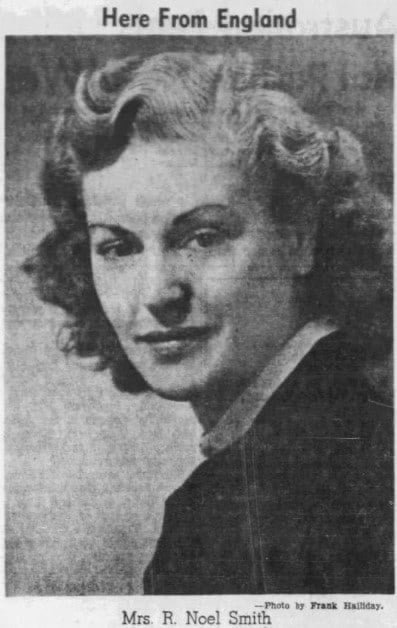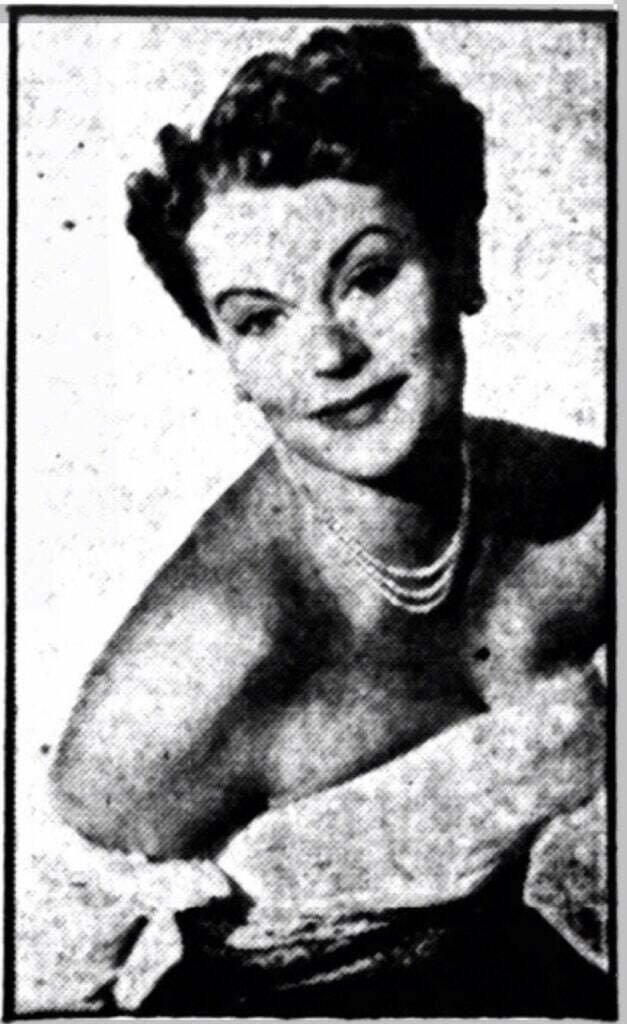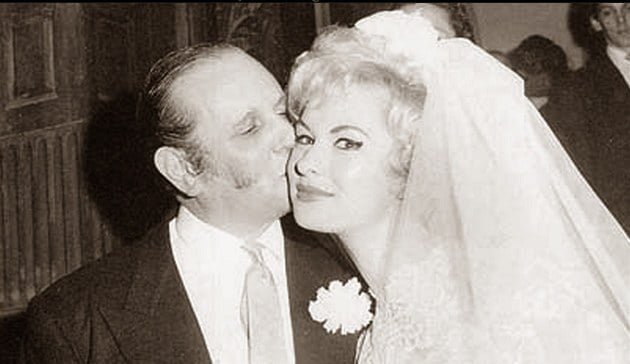Esmeralda Gullan, also known as Esmeralda Noel Smith, was a talented young starlet who was beginning to become famous before the outbreak of World War II. After the war, she became a strong and powerful business woman and, by 1955, Esme had created four unique establishments in and around Knightsbridge, Mayfair, and Belgravia including the notoriousLondon night club, Esmeralda’s Barn. However, Esme Gullan’s life soon came to a tragic end. After her death, her beloved Esmeralda’s Barn would fall into the hands of such infamous London gangsters as the Kray twins and Billy Hill via a self-confessed Satanist named Horace Dibben. The latter was the intelligence-linked husband of Mariella Novotny, who played a central role in the Profumo Affair, leading to the downfall of the British government and the alleged blackmail of then-president-elect John F. Kennedy. Song for Esmeralda is the first instalment of a multi-part series that uncovers the deeper, previously unreported stories that go both behind and beyond the Profumo Affair.
The Queen of Night Clubs
Esme Gullan was born in Belfast around 1911 to her father, Hector F. Gullan, from Swansea, Wales, and her Chilean mother, Laura Beatriz Freeman Gullan (born Peyne Silva). For some unexplained reason, Esme Gullan, most likely born Mary Esmeralda Peyne Silva Freeman Gullan, is not included on many of the family tree records online which cover the Freeman Gullan ancestry. Regardless, it appears that Esme Gullan grew up with the family unit in Belfast, where her father was the Assistant City Surveyor of the ever growing capital city of Northern Ireland. Esme had at least three siblings; her sister, Rhona Beatriz Peyne Silva Freeman Gullan, her older brother, Hector Wilson Peyne Silva Freeman Gullan, as well as Archibald Gordon Peyne Silva Freeman Gullan, with the latter going on to be a honours graduate at Queen’s University and who would later become Chief Superintendent Director of Works at the Air Ministry.

Esme attended Ashleigh House School in Greater Belfast and was recorded in the local papers as competing in various school writing and drama competitions, with the plucky young lady coming in 1st or 2nd in her age category and seeming to excel specifically in the performative arts from a very early age. Indeed, Esme had been heading towards the stage almost from the day she was born and she took her first tentative steps into show business as a teenager, making appearances at both the Gate Theatre in Dublin and the Abbey Theatre in Belfast. She won the juvenile lead in Ashley Duke’s “The Man With the Load of Mischief” at the Abbey theatre and soon went to Dublin to capitalise on her initial success.
Her interview at the Gate theatre in Ireland’s capital is recounted in a later newspaper article, where Esme recalls insisting that the manager of the theatre hear her “in a piece that I have learned up.” However, Esme’s family were not so keen on her career path and had demanded that she study “domestic economy” and to “stop her nonsense” about the stage. It’s for this reason that, when Esme was 17 years-old, she ran away from home—which may explain her omission from the majority of Freeman Gullan family records—and she arrived in London as a penniless young stage actor.
She soon found work as a hostess in a West End hotel, where she was provided meals during working hours and paid £5 a week. Soon after, Esme took an opportunity to model swimsuits and eventually became what one Sunday Mirror article describes as “the toast of London” with that same article also noting that, “Millionaires offered her marriage.” Esmeralda had always felt she was destined for great things and she had been determined to succeed from the moment she left her homeland in Northern Ireland for the big city of London.
Esme already had some relatively famous cousins working within show business. One of her cousins was Marjorie Gullan, who was at this time a very well-known vocal coach and director of the School of Speech in London. Another of her cousins was Campbell Gullan, an actor and producer who appeared in some very interesting movies, one film in particular which was created to counter Nazi propaganda before the war with strange consequences. Jew Süss is a 1934 British philo-semitic film following the romance of Joseph Süß Oppenheimer, a real life German Jewish banker and court Jew from the 18th century. The film, created to counter rising Nazi propaganda about Jewish people, saw Campbell Gullan play the Prince of Thurn and Taxi in a picture which was described by the Times correspondent as “indistinct”. In 1940, Goebbels’s had Terra Film produce another version of Oppenheimer’s life story, entitled Jud Süß, which is now often referred to as one of the most anti-semitic films of all time.
In 1938, Esme Gullan stood on a West End stage for the first time as the juvenile lead in Moonshine at the Ambassador Theatre. In the following months and years, she appeared in multiple stage productions and also made her on-screen debut leading up to the war. Her pre-war films included an early Charles Laughton film, a small part in the screen adaptation of Pygmalion, and an appearance in a version of Don Juan. By this time, Esme had met her future husband, who was a RAF Flight Lieutenant named Ronald Noel-Smith and, even though she would be offered a role in the 1939 autumn West End production of Juno and the Paycock, she was persuaded by the outbreak of World War II to get married earlier than expected.
An announcement in the Northern Whig newspaper on 30 September 1939, entitled, “Belfast Bride in Leeds” reported that: “Though she has been living mainly in London during recent years she has not lost touch with her friends at home.” Various newspapers at the time reported the marriage of this up-and-coming sweetheart of the stage to this proud serviceman. It was also widely reported that Esme had decided to leave the theatre behind her so as to settle down to married life. By 1942, Wing Commander Ronald Noel Smith had been made the commanding officer at the RAF station at De Winton, Alberta, Canada.
During a wartime visit to her husband, Esme was recorded in the Calgary Herald newspaper discussing make up rations, dining-out in wartime London, her stage appearances in the Ambassador’s Theatre and other West End venues, as well as her radio work. Described in the latter article as an “attractive girl” with “golden-pink skin, gold-brown wavy hair, and wide-set blue eyes”, the newly married Esmeralda Noel-Smith had begun her war years training as an ambulance driver but was soon hunted down to be part of the Entertainments National Service Association (ENSA), an organisation established in 1939 by Basil Dean and Leslie Henson to provide entertainment for British armed forces personnel during WWII. Esme had returned to treading the boards, entertaining the troops, and hobnobbing with various other stars of the stage and screen who were also part of the ENSA.
As the war ended, Esme and her rather underwhelming husband Ronald were heading towards divorce, and by 1947 Esme Noel Smith made herself a single lady again. As a bachelorette, she went to work building a better life for herself by starting up as an interior decorator, where she began to purchase large London properties and convert them into luxury flats. The investment and hard work soon paid off for Esme, as the London post-war property market was booming and she now had some money to invest in her many other projects. She went on to invest in her first London club alongside three partners, one of them being Elspeth March, the ex-wife of the aforementioned film director Stewart Granger.
This small group would start a “buttery” in Dover Street, Piccadilly, of which Esme eventually became the sole proprietor in early 1952. The Belfast Telegraph described the Dover Buttery House of Esme Gullan in an article dated 29 October 1954, stating: “Its atmosphere is redolent of a Dickensian coaching house with candle light and heavy oak beams, and, being fully licensed till midnight, it caters largely for theatre-goers.” Esme Gullan, who regularly used her married name of Esme Noel-Smith while representing the higher class establishments which she ran, was setting her sights on becoming a major name on London’s elite night club scene, an accolade which may have eventually been one of the main causes of her untimely demise.
Once Esme’s various business enterprises had brought in enough funds, she went on to purchase two little mews cottages off Halkin Street in Belgravia with the intention of converting them into The Montrose Club. When she did, the Montrose Club became rumoured to have the smallest dance-floor in London, famous for its “oyster bar” decorated with sea shells. Esme had personally hunted down two authentic “Neapolitan chefs” from one of the most famous restaurants in Europe at the time, the ‘Consone de Marie’ in Capri, to make sure that the establishment drew in the elite local clientele and gave a truly authentic experience to her wealthy customers.
Esme was a woman who wanted to create something special and unique with whatever she did. By the beginning of 1954, everything was going Esme Gullan’s way, she was planning on opening another buttery in Knightsbridge and even thinking of launching a night club in her home-town of Belfast. She was also preparing to take over the Torch Theatre in Wilton Place which she intended to “run on revue lines with dancing on the stage.” Esme was busy creating speciality clubs and dining establishments fit for the wealthiest of London’s elite. She was a force to be reckoned with, a true female pioneer whose life would have personified the swinging sixties, if she had managed to live that long. Esme was lively and vivacious, she was protective over her friends and loved ones, and her personality was described during this period as being both tempestuous and courageous.

In March 1954, this vibrant and attractive young lady would kick up a storm in Nottingham, England. Described in newspaper reports at the time as “an attractive blonde”, Esmeralda was in a Nottingham transport cafe at 1:30am on the night in question, when a Police Sergeant called Frank Taylor entered the premises to speak to her about her vehicle. She was eventually fined £10 for “sounding a horn and parking on the wrong side of the road at night, failing to display a licence, and failing to produce a driving licence and insurance certificate,” but not before the trendy strapless dress she was wearing caused a scene. Sergeant Taylor first entered the cafe with the sole intention of reprimanding the club owner for her many vehicle violations but, after taking one look at her attire, he instead began to criticise her provocative look. The strapless cocktail dress in question which Esme had donned that evening wasn’t the reason she got in trouble with the law, but it did manage to get her face in the Daily News newspaper based in London, as well as making the pages of the Daily Mirror on the same day, which featured an image of Esme Gullan, or Mrs. Noel-Smith as they refer to her, in the offending strapless number. The latter article, printed on Thursday 11 May 1954, stated that Sergeant Taylor told Mrs. Noel-Smith that her appearance was “not becoming” and that lorry drivers were “watching her and laughing.” The Weekly Dispatch newspaper reported in March 1955 that the day after Esmeralda had appeared in the aforementioned newspapers wearing the strapless dress, new menu cards had been printed at one of her restaurants with a picture of her wearing the dress with a note below which read: “The success of the restaurant lies in the personality of charming Esme Noel-Smith. She is a keen sportswoman, a racehorse owner, and a shrewd observer of life.”
Around this time, Esme became the part-proprietor of the old Torch Theatre, an establishment in Knightsbridge which was to be renamed “Esmeralda’s Barn.” The Barn was soon to become one of the most exclusive London haunts for the rich and famous. Within a few years, this venue was also to become a notorious den of villainy, gambling and intelligence operations, but not on Esme’s watch. Esmeralda’s Barn was to be the centrepiece of her growing list of establishments and she had it decorated with horseshoes and cartwheels, with the walls covered by rustic-looking planks of wood and decorative straw. To design the night club originally, Esmeralda had commissioned Pietro Annigoni, who had painted a recent portrait of Queen Elizabeth II, but after Annigoni completed the work, Esmeralda would, for some undisclosed reason, cover up his designs and, as with everything else in her life, chose to do what she desired instead. She had reportedly met Annigoni while she was holidaying in Italy and he had asked to paint a portrait of her, she instead convinced him to paint the large mural on the wall of Esmeralda’s Barn, which he did along with his then student, Timothy Whidborne. The mural would remain covered-up until 1960 when the then manager of Esmeralda’s Barn, Stefan de Fay, had it restored.
Pietro Annigoni had been a regular at the Montrose Club with it being reported that the Italian artist had taken time out of painting Queen Elizabeth II to show off his other skills. At Esme’s Montrose Club, one evening in December 1954, the actress, Mrs Marjorie Huntingdon Hartford, who went by the stage name Marjorie Steele, and Pietro Annigoni had discovered during a meal that they were both master forgers and went on to show off their illicit skills. Marjorie’s husband, who we will cover in detail later-on in this series, wrote down his signature and his wife and Pietro Annigoni both attempted a forgery. When the results were shown to the people at the dinner table, it was reported that no one could decipher which was the genuine signature.
Esme Gullan‘s Closing Act
Esmeralda was a free spirited trailblazer, a truly positive example for all womankind. She was an independent business woman in one of the most competitive night club scenes in the world at a time when society may not have been ready for such simple advances in gender parity. Less than a year after the beautiful Esmeralda Gullan had appeared in the Daily Mirror wearing her infamous strapless dress, that same photo again appeared in a newspaper. However, this time, printed on the pages of the Sunday Mirror on 20 March 1955, the headline would read: “Queen of Night Clubs Dies.” Tom Tullet, the reporter who wrote the article, started by writing, “Beautiful Mrs. Esmeralda Noel-Smith, London’s greatest night club queen since Kate Meyrick [the infamous ‘nightclub queen’ of 1920’s Soho] of the “43 Club,” died yesterday.”
In fact, Esme would be just one of a slew of female nightclub owners and hostesses who’d turn up dead over the following few years, as well as other suspicious disappearances connected with Esmeralda’s Barn and other female-run night clubs in the area. The articles reporting her untimely demise described Esme as one of the “gayest of London’s socialites” with it being noted that admirers had given her the name the “Green Goddess” due to her green eyes and her “perfect figure.” Even though she had only recently started running Esmeralda’s Barn at the time of her death, the previously mentioned article reporting her death describes “the Barn” as being her favourite of all the establishments she owned.

Esmeralda died on 18 March 1955 in a gas-filled room inside her flat in Kinnerton Street, Belgravia. Her death was ruled an accident, as were the majority of the other female nightclub owners and hostesses deaths which occurred over the next few years. The official story was soon reported that the gas fire had been left on in the apartment and “blow back” had extinguished the flame, leaving the room to fill with gas. But, like many of the cases we will examine, this official story, which was widely-reported and had soon become the prevailing narrative, was neither accurate nor factual.
Esme was found alive but unconscious, along with another lady, a 21 year-old club hostess named Valerie Evelyn Fisher who eventually managed to make a full recovery. On Saturday 23 April 1955, the Daily Mirror reported that Esmeralda had left the Montrose Club, in Montrose Place, after the club had closed on 18 February 1955. The article goes on to state that she was later found dying on her “divan” with 21 year-old Valerie Fisher laying beside her, also unconscious. It was reported that Esmeralda regained consciousness for a little while and that she was able to answer simple questions, but the reports state clearly that “she was never able to give an account of what happened.”
The Westminster coroner would hear details outlining how Esmeralda and Valerie returned to her flat with two men, where they partied until 4 or 5 am. The Belfast Telegraph reported on 22 April 1955 that Valerie Fisher gave evidence at the inquest about the events of that night, stating: “But then it was too late for me to go home so I decided to stay with Esme.” Miss Fisher went on to say: “I went to bed before the party finished. I had a bedroom of my own I had the light on. I remember waking up when Esme came in and said she was going to bed. Her bedroom was next door. I turned the light off and went back to sleep. I don’t remember any more after that.”
In the same inquest, this depiction of events was soon contradicted by the testimony of Inspector Bruce Dix who had discovered the two women unconscious but still alive. Dix would state that he had found Esme and Valerie lying on the divan bed together, not in separate rooms as Miss Fisher had stated. Dix would also tell the coroner, Mr. H. Neville Stafford, that the portable gas-fire had not gone out due to ‘blow-back’ but was in actual fact, still alight but not fully burning.
The aforementioned Belfast Telegraph article also reported the testimony of Frederick Smith, described as a “Gas Board research chemist”, who said the tube of the portable gas fire had a leak. A Daily Mirror article published on the 23 April 1955 expanded on the statements by Mr Smith, who worked specifically for North Thames Gas Board. He tested the equipment and how it had been installed, claiming that the installation was “sound” but stating that when the tube on the gas fire was in a certain position there was a leak. However, the Mirror article also reported: “Further tests showed that though the room was not well ventilated, the fire burning for up to six hours would not bring about dangerous conditions in the atmosphere. But with even a small leak, the air would be dangerous after a period.” Even though the tests by the Gas Board expert had concluded that the fire burning for about six hours wouldn’t “bring about dangerous conditions in the atmosphere”, no further investigations into the circumstances surrounding the death of Esme Gullan took place.
Curiously, Esme was recorded as leaving a reasonably large sum of money to someone rather unexpected. It was reported in the Daily Herald on 18 May 1955 that: “Mrs. Esmeralda Noel-Smith left £8,535 (£1,952 net) – all to Mr. Hywel Glynne Jones, solicitor, of Wrexham, North Wales.” But the article fails to mention that Mr. H Glynne Jones was also the Labour candidate for the West Flintshire division in the General Election. However, a Chelsea News and General Advertiser piece, published on 27 May 1955, explains that: “Mr. Jones’ wife was a cousin of Mrs. Noel-Smith,” going on to say: “Mr. Jones, who is the executor, has been running the two night clubs, the Montrose and Esmeralda’s Barn.”
Hywel Glynne Jones was the son of Alderman Cyril O. Jones, a prominent and argumentative solicitor, who had also contested the same parliamentary seat of West Flintshire twice before World War II. In 1955, Cyril Jones refused to take any part in the General Election in which his son was a candidate because the recently installed Postmaster-General, Dr. Charles Hill – who reportedly had “headquarters backing” of both Conservatives and Socialists – threatened to ban all political broadcasting in Wales.
On 17 June 1955, a Westminster & Pilmico News article published a pedantic correction at the bequest of Hywel Glynne Jones, stating: “We have been asked by Mr. H. Glynne Jones to state that it was inaccurate to describe Mrs. Noel-Smith as a night club owner, as her properties, the Montrose and Esmeralda’s Barn are members clubs and the Dover Buttery and the Knightsbridge Buttery are catering establishments.”
As a political candidate, Hywel Glynne Jones had probably been keen not to become associated with Esmeralda’s London night clubs. It was almost impossible to have an establishment in the West End of London during this period without being connected with the elements of organised crime who were running protection racquets targeting such venues. There were rumours that Esmeralda, who was reported as being a “part-proprietor” of Esmeralda’s Barn, had to go into business with the mob right from the start. Author Lillian Pizzichini, who I will mention again when closing out this part of the series, claimed that Esmeralda had been running the Barn with a low-level London gangster named Ronnie Dice who ended up owing a debt to the more infamous London gangster of the era, Billy Hill, but there is little evidence to back-up this rumour. Yet, it must be noted that no one was free from the grip of organised crime in the London club scene during much of this period, and only a few years later the infamous Kray twins bought their own stake in Esmeralda’s Barn, reportedly from Billy Hill.
The First in a Series of Mysterious Deaths
Esmeralda’s story, although filled with intrigue, mystery and contradicting evidence, is just one part of a larger saga. On its own, her life could be seen as an adventure which came to a very tragic end, but when combined with the other parts of this complex tale, Esme’s life and death become a grander, more illusive mystery. For Esmeralda Gullan was but one of a series of bizarre, and supposedly accidental, deaths which occurred throughout the London club scene over a very short period. Over the following couple of years many women with significant stakes in London night clubs would turn up dead or go missing, including Barbara Knox Marsh, Linda Justice, Patsy Morgan Dibben, Dorothy Foxon, Janet Curtis Bennett and Pamela Gale, as well as Ruth Ellis, the last woman to be hanged in Britain.
Esmeralda’s Barn was not just a run-of-the-mill night club in some impoverished part of London. The Barn was located in one of the more affluent parts of the capital and was soon catering to some of the biggest names in British high society. In fact, within a year of Esmeralda Gullan’s tragic death, her vibrant club had become a haunt for members of the royal family, gangland criminals, intelligence agents, and the apparent home to a strange Satanic black magic circle which was associated to a peculiar man named Horace “Hod” Dibben. In fact, Esmeralda’s Barn would fall into the hands of Horace Dibben within a year of Esme’s death, and he would install his “Pygmalion girl” Patsy Morgan Dibben to run the night club.

By the turn of the following decade, Esmeralda’s Barn became a gambling den of the kind which Esme herself would never have allowed and was part owned by such people as the infamous Kray twins. It would also share significant links to some of the most enthralling espionage scandals of post-war Britain.
One of the saddest parts of Esmeralda’s story is that she and her many accomplishments were soon forgotten by those who were writing the history books. In a book by Douglas Thompson entitled: Stephen Ward: Scapegoat. They All Loved Him… But When It Went Wrong They Killed Him, Esmeralda’s memory is almost completely covered by the sands of time, with the author stating: “The path was to Esmeralda’s, a club established by Patsy Morgan-Dibben in a prime spot on Wilton Street in Knightsbridge, opposite the Berkeley Hotel. She was friends with Kim Waterfield, and Pietro Annigoni (whose 1956 portrait of HM the Queen had brought him international fame and commissions) created the interior design for the club.” Not only was Douglas Thompson’s retelling of the history of Esmeralda’s creation inaccurate, it was also disrespectful to a truly inspiring British female pioneer. Esmeralda Gullan has become a footnote in a constantly rewritten history of the club scene in London during this period.
Thompson’s book, although inaccurate in places, also lists some of those who frequented Esmeralda’s Barn, stating: “At Esmeralda’s, there were many famous guests, including Bill Astor, with his friend Stephen Ward, the usual Royals and Hollywood personalities mixed with indiscretions and vodka and heavy drugs, which were catching up with whisky and gin as the stimulant of choice while Benzedrine spun the clock. With its discreetly owned multi-roomed properties, often taken by overseas embassies, Esmeralda’s became a complement to the Eve Club.”
Douglas Thompson isn’t the only author who published stories of Esmeralda’s Barn which would prove to be erroneous. For instance, in the previously mentioned Lillian Pizzichini’s book, entitled ‘The Novotny Papers’, the author also makes inaccurate statements concerning Esme and the Barn. Pizzichini states that: “Esmeralda was found dead of an overdose in the Baker Street flat of her accountant,” where in reality Esmeralda was found dying of gas inhalation in her own flat. She also claims that Esmeralda’s Barn was: “Originally named after the woman who had run it as a lesbian’s club,” but there is absolutely zero evidence on which this statement can be supported and much evidence to the contrary. She also states that: “The launch of Esmeralda’s Barn in 1955, with interior design by Annigoni and carefully contrived marketing, soon brought the young Guards officers, the debutantes and the celebrities.” Although it is true that celebrities were drawn in, the rumour that Annigoni had solely designed the interior of the Barn persist even though his mural had been quickly covered up by Esmeralda herself and not revealed again until 1960.
Mary Esmeralda Peyne Silva Freeman Gullan was dead and buried and soon her name, reputation, and the true story behind her life’s deeds, disappeared with her. Her well known vibrant energy and kindness were instead replaced by poorly researched throw away lines by people who seem not to care about the facts surrounding her life and death.
Esmeralda’s Barn in particular evolved quickly after her death. It was during the peak of the Cold War, spies frequented the darkened rooms of London’s elite night clubs, passing off their secrets to like-minded ideologues, making deadly and dastardly deals in the shadows. Horace Dibben, the ruling king of London’s elite sex parties, was about to take over Esmeralda’s Barn and, soon after, a small group of intelligence-linked men and women would cause the downfall of the British government.
In the next part of this series, we will investigate the many other suspicious deaths and disappearances of night club girls in London during this period. With Esmeralda Gullan dead, many other women were soon to follow and were unable to escape the deadly night club trap.











Johnny…did you see this site on the Profumo Affair?
This suggests there were more mysterious murders, not just female hostesses of clubs frequented by spooks, royalty, celebrities.
https://wimpolemuse.blogspot.com/2016/09/wimpole-muse-introduction.html